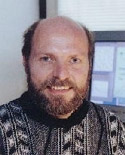Gunter Schütz is Professor of Physics at Bonn University and Research Scientist at the Forschungszentrum Jülich, Germany. He studied Physics, Ancient Semitic Languages and Comparative Religion at Marburg University and Bonn University. After doctoral studies in physics at Bonn University and at the Weizmann Institute of Science (Rehovot, Israel), he undertook postdoctoral positions at the Weizmann Institute (1991-1993) and at Oxford University (1993-1996). In 2000 he received the Gustav-Hertz-Prize of the Deutsche Physikalische Gesellschaft. He has been visiting scientist and visiting professor at academic institutions in the United States, England, France, Brazil and Germany. Prof. Schütz’s research interests are in mathematical physics, in particular the foundations of nonequilibrium statistical mechanics. This includes the investigation of collective phenomena in diverse complex systems such as polymer melts, zeolites and quantum spin systems.
Prof. Schütz lectures and publishes on the relation of science and religion mainly for a broad audience. His main interest is in epistemological problems. Since 1991 he has been a member of the Karl-Heim-Gesellschaft and since 1996 editor of the journal Evangelium und Wissenschaft.
Recent publications in science and religion
- Gunter M. Schütz, in Can science dispense with religion?, M. Golshani (ed.), 3rd edn, 2004 (Institute for Humanities and Cultural Studies, Teheran)
- Gunter M. Schütz, ‘Wie offen ist ein wissenschaftliches Weltbild?’, Evangelium und Wissenschaft 44, 4-23 (2004)
- Gunter M. Schütz, ‘Hat die Relativitätstheorie irgendetwas mit Religion zu tun?’, Evangelium und Wissenschaft 45, 4-11 (2005)
- Gunter M. Schütz, ‘Wolfgang Gentner und die Atombombe in Nazi-Deutschland: Vom Offizier des Heereswaffenamts zum Ehrenmitglied des Weizmann-Instituts in Israel’, Evangelium und Wissenschaft (2006)
- Gunter M. Schütz, ‘Nur Mythen in der Bibel?’, Christsein Heute 113(3), 10-12 (2006)
Selected recent science publications
- G.M. Schütz ’Exactly Solvable Models for Many-Body Systems Far From Equilibrium’, in Phase Transitions and Critical Phenomena 19, 1 – 251, C. Domb und J. Lebowitz (eds.), (Academic Press, London, 2001).
- Y. Kafri, E. Levine, D. Mukamel, G.M. Schütz and J. Török, ‘Criterion for phase separation in one-dimensional driven systems’, Phys. Rev. Lett. 89 (2002), 035702.
- A. Rakos, M. Paessens and G.M. Schütz, ‘Hysteresis in one-dimensional reaction-diffusion systems’, Phys. Rev. Lett. 91 (2003), 238302.
- G. Schönherr and G.M. Schütz ‘Exclusion process for particles of arbitrary extension:
Hydrodynamic limit and algebraic properties’, J. Phys. A 37 (2004), 8215-8231. - D. Gobert, C. Kollath, U. Schollwöck and G.M. Schütz, ‘Real-time dynamics in spin-1/2 chains with adaptive time-dependent DMRG’ cond-mat/0409692, Phys. Rev. E 71 (2005), 036102.
- A. Brzank and G.M. Schütz ‘Molecular traffic control in porous nanoparticles’
cond-mat/0503068, Appl. Catalysis A 288 (2005), 194-202. - R.D. Willmann, S. Großkinsky und G.M. Schütz ‘Dynamical origin of spontaneous symmetry breaking in a field-driven nonequilibrium system’ cond-mat/0504558, Europhys. Lett. 71 (2005), 542-548.
- V. Popkov, M. Salerno und G.M. Schütz ‘Entangling power of permutation invariant quantum states’ quant-ph/0506209, Phys. Rev. A {bf 72} (2005) 032327.
- A. Rakos and G.M. Schütz ‘Bethe ansatz and current distribution for the TASEP with particle-dependent hopping rates’ cond-mat/0506525, In Press in: Markov Proc. Rel. Fields.




